Health Promotion in Minority Populations
VerifiedAdded on 2023/04/26
|7
|1496
|374
AI Summary
This paper discusses the health disparities faced by the Black African American population in America and the barriers they face in accessing healthcare. It also explores the cultural theories and beliefs of this group and suggests health promotion interventions to address the issue.
Contribute Materials
Your contribution can guide someone’s learning journey. Share your
documents today.
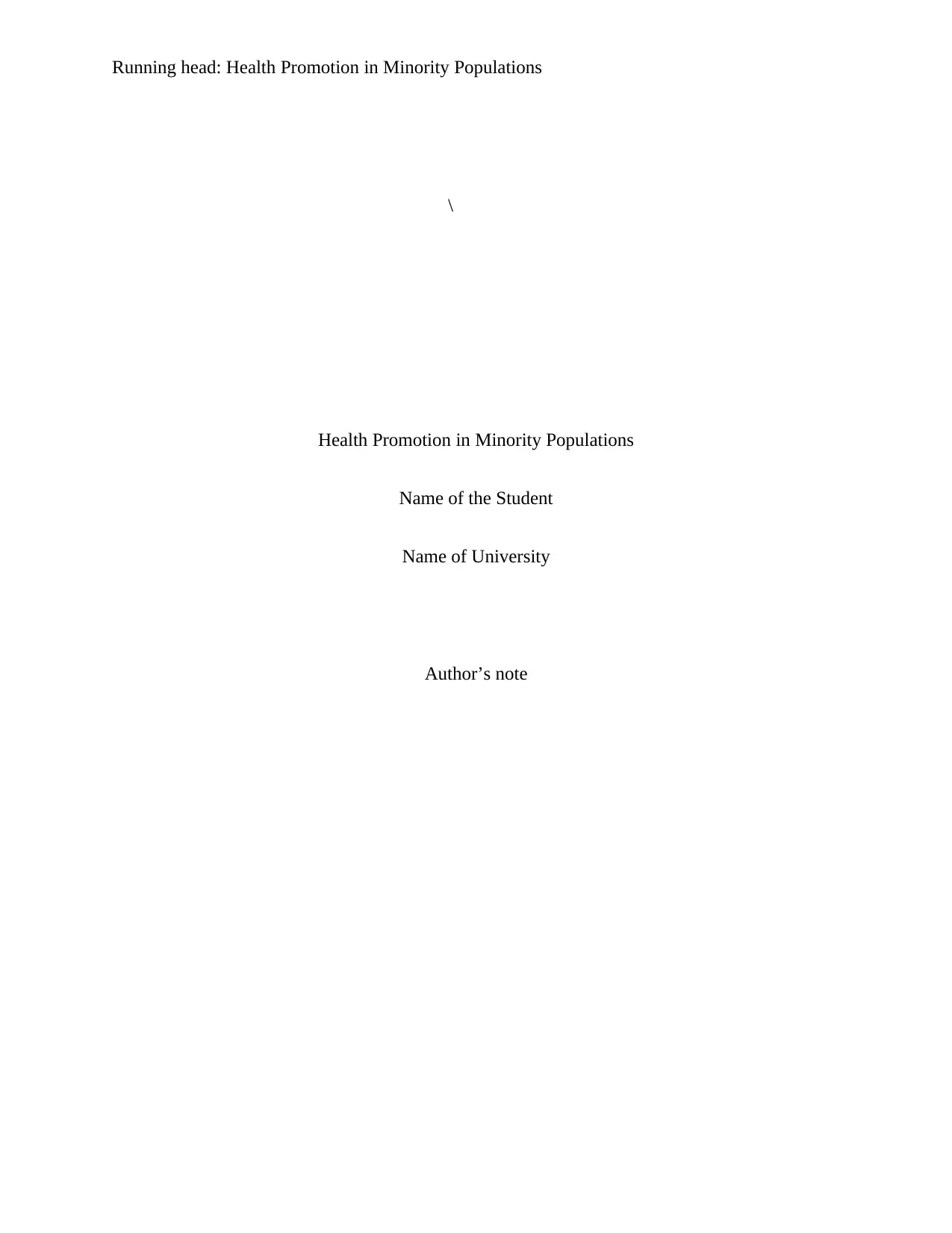
Running head: Health Promotion in Minority Populations
\
Health Promotion in Minority Populations
Name of the Student
Name of University
Author’s note
\
Health Promotion in Minority Populations
Name of the Student
Name of University
Author’s note
Secure Best Marks with AI Grader
Need help grading? Try our AI Grader for instant feedback on your assignments.
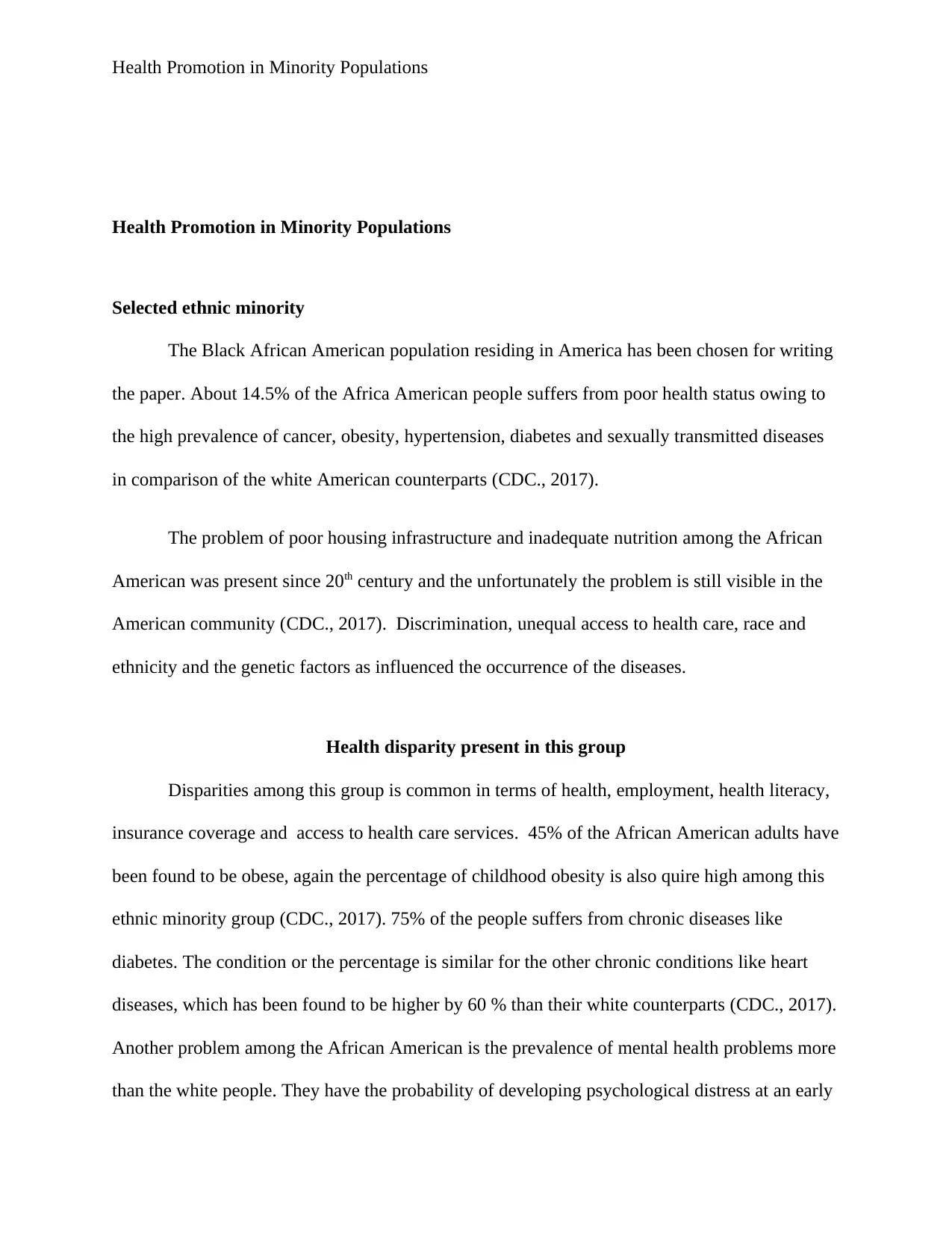
Health Promotion in Minority Populations
Health Promotion in Minority Populations
Selected ethnic minority
The Black African American population residing in America has been chosen for writing
the paper. About 14.5% of the Africa American people suffers from poor health status owing to
the high prevalence of cancer, obesity, hypertension, diabetes and sexually transmitted diseases
in comparison of the white American counterparts (CDC., 2017).
The problem of poor housing infrastructure and inadequate nutrition among the African
American was present since 20th century and the unfortunately the problem is still visible in the
American community (CDC., 2017). Discrimination, unequal access to health care, race and
ethnicity and the genetic factors as influenced the occurrence of the diseases.
Health disparity present in this group
Disparities among this group is common in terms of health, employment, health literacy,
insurance coverage and access to health care services. 45% of the African American adults have
been found to be obese, again the percentage of childhood obesity is also quire high among this
ethnic minority group (CDC., 2017). 75% of the people suffers from chronic diseases like
diabetes. The condition or the percentage is similar for the other chronic conditions like heart
diseases, which has been found to be higher by 60 % than their white counterparts (CDC., 2017).
Another problem among the African American is the prevalence of mental health problems more
than the white people. They have the probability of developing psychological distress at an early
Health Promotion in Minority Populations
Selected ethnic minority
The Black African American population residing in America has been chosen for writing
the paper. About 14.5% of the Africa American people suffers from poor health status owing to
the high prevalence of cancer, obesity, hypertension, diabetes and sexually transmitted diseases
in comparison of the white American counterparts (CDC., 2017).
The problem of poor housing infrastructure and inadequate nutrition among the African
American was present since 20th century and the unfortunately the problem is still visible in the
American community (CDC., 2017). Discrimination, unequal access to health care, race and
ethnicity and the genetic factors as influenced the occurrence of the diseases.
Health disparity present in this group
Disparities among this group is common in terms of health, employment, health literacy,
insurance coverage and access to health care services. 45% of the African American adults have
been found to be obese, again the percentage of childhood obesity is also quire high among this
ethnic minority group (CDC., 2017). 75% of the people suffers from chronic diseases like
diabetes. The condition or the percentage is similar for the other chronic conditions like heart
diseases, which has been found to be higher by 60 % than their white counterparts (CDC., 2017).
Another problem among the African American is the prevalence of mental health problems more
than the white people. They have the probability of developing psychological distress at an early
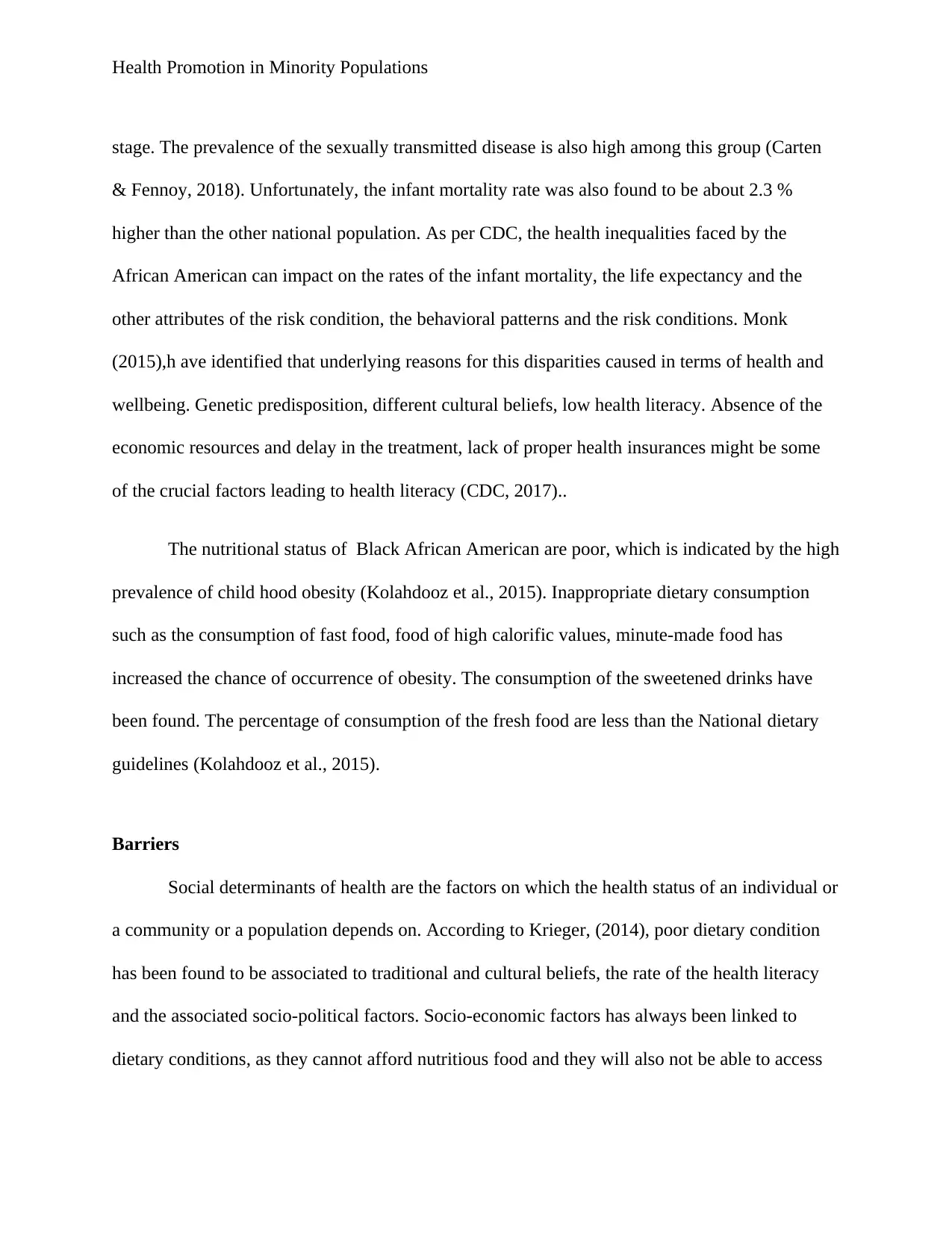
Health Promotion in Minority Populations
stage. The prevalence of the sexually transmitted disease is also high among this group (Carten
& Fennoy, 2018). Unfortunately, the infant mortality rate was also found to be about 2.3 %
higher than the other national population. As per CDC, the health inequalities faced by the
African American can impact on the rates of the infant mortality, the life expectancy and the
other attributes of the risk condition, the behavioral patterns and the risk conditions. Monk
(2015),h ave identified that underlying reasons for this disparities caused in terms of health and
wellbeing. Genetic predisposition, different cultural beliefs, low health literacy. Absence of the
economic resources and delay in the treatment, lack of proper health insurances might be some
of the crucial factors leading to health literacy (CDC, 2017)..
The nutritional status of Black African American are poor, which is indicated by the high
prevalence of child hood obesity (Kolahdooz et al., 2015). Inappropriate dietary consumption
such as the consumption of fast food, food of high calorific values, minute-made food has
increased the chance of occurrence of obesity. The consumption of the sweetened drinks have
been found. The percentage of consumption of the fresh food are less than the National dietary
guidelines (Kolahdooz et al., 2015).
Barriers
Social determinants of health are the factors on which the health status of an individual or
a community or a population depends on. According to Krieger, (2014), poor dietary condition
has been found to be associated to traditional and cultural beliefs, the rate of the health literacy
and the associated socio-political factors. Socio-economic factors has always been linked to
dietary conditions, as they cannot afford nutritious food and they will also not be able to access
stage. The prevalence of the sexually transmitted disease is also high among this group (Carten
& Fennoy, 2018). Unfortunately, the infant mortality rate was also found to be about 2.3 %
higher than the other national population. As per CDC, the health inequalities faced by the
African American can impact on the rates of the infant mortality, the life expectancy and the
other attributes of the risk condition, the behavioral patterns and the risk conditions. Monk
(2015),h ave identified that underlying reasons for this disparities caused in terms of health and
wellbeing. Genetic predisposition, different cultural beliefs, low health literacy. Absence of the
economic resources and delay in the treatment, lack of proper health insurances might be some
of the crucial factors leading to health literacy (CDC, 2017)..
The nutritional status of Black African American are poor, which is indicated by the high
prevalence of child hood obesity (Kolahdooz et al., 2015). Inappropriate dietary consumption
such as the consumption of fast food, food of high calorific values, minute-made food has
increased the chance of occurrence of obesity. The consumption of the sweetened drinks have
been found. The percentage of consumption of the fresh food are less than the National dietary
guidelines (Kolahdooz et al., 2015).
Barriers
Social determinants of health are the factors on which the health status of an individual or
a community or a population depends on. According to Krieger, (2014), poor dietary condition
has been found to be associated to traditional and cultural beliefs, the rate of the health literacy
and the associated socio-political factors. Socio-economic factors has always been linked to
dietary conditions, as they cannot afford nutritious food and they will also not be able to access
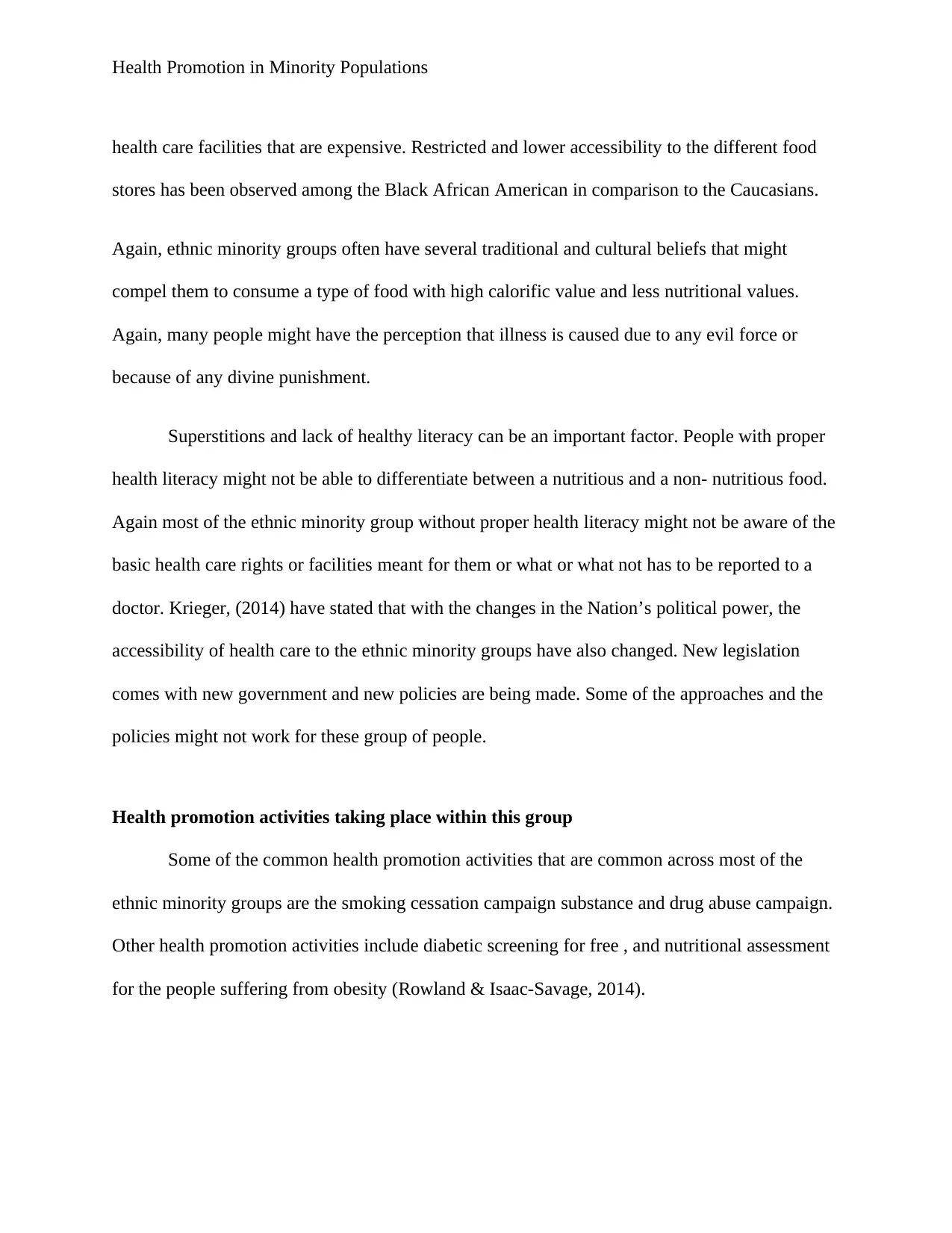
Health Promotion in Minority Populations
health care facilities that are expensive. Restricted and lower accessibility to the different food
stores has been observed among the Black African American in comparison to the Caucasians.
Again, ethnic minority groups often have several traditional and cultural beliefs that might
compel them to consume a type of food with high calorific value and less nutritional values.
Again, many people might have the perception that illness is caused due to any evil force or
because of any divine punishment.
Superstitions and lack of healthy literacy can be an important factor. People with proper
health literacy might not be able to differentiate between a nutritious and a non- nutritious food.
Again most of the ethnic minority group without proper health literacy might not be aware of the
basic health care rights or facilities meant for them or what or what not has to be reported to a
doctor. Krieger, (2014) have stated that with the changes in the Nation’s political power, the
accessibility of health care to the ethnic minority groups have also changed. New legislation
comes with new government and new policies are being made. Some of the approaches and the
policies might not work for these group of people.
Health promotion activities taking place within this group
Some of the common health promotion activities that are common across most of the
ethnic minority groups are the smoking cessation campaign substance and drug abuse campaign.
Other health promotion activities include diabetic screening for free , and nutritional assessment
for the people suffering from obesity (Rowland & Isaac-Savage, 2014).
health care facilities that are expensive. Restricted and lower accessibility to the different food
stores has been observed among the Black African American in comparison to the Caucasians.
Again, ethnic minority groups often have several traditional and cultural beliefs that might
compel them to consume a type of food with high calorific value and less nutritional values.
Again, many people might have the perception that illness is caused due to any evil force or
because of any divine punishment.
Superstitions and lack of healthy literacy can be an important factor. People with proper
health literacy might not be able to differentiate between a nutritious and a non- nutritious food.
Again most of the ethnic minority group without proper health literacy might not be aware of the
basic health care rights or facilities meant for them or what or what not has to be reported to a
doctor. Krieger, (2014) have stated that with the changes in the Nation’s political power, the
accessibility of health care to the ethnic minority groups have also changed. New legislation
comes with new government and new policies are being made. Some of the approaches and the
policies might not work for these group of people.
Health promotion activities taking place within this group
Some of the common health promotion activities that are common across most of the
ethnic minority groups are the smoking cessation campaign substance and drug abuse campaign.
Other health promotion activities include diabetic screening for free , and nutritional assessment
for the people suffering from obesity (Rowland & Isaac-Savage, 2014).
Secure Best Marks with AI Grader
Need help grading? Try our AI Grader for instant feedback on your assignments.
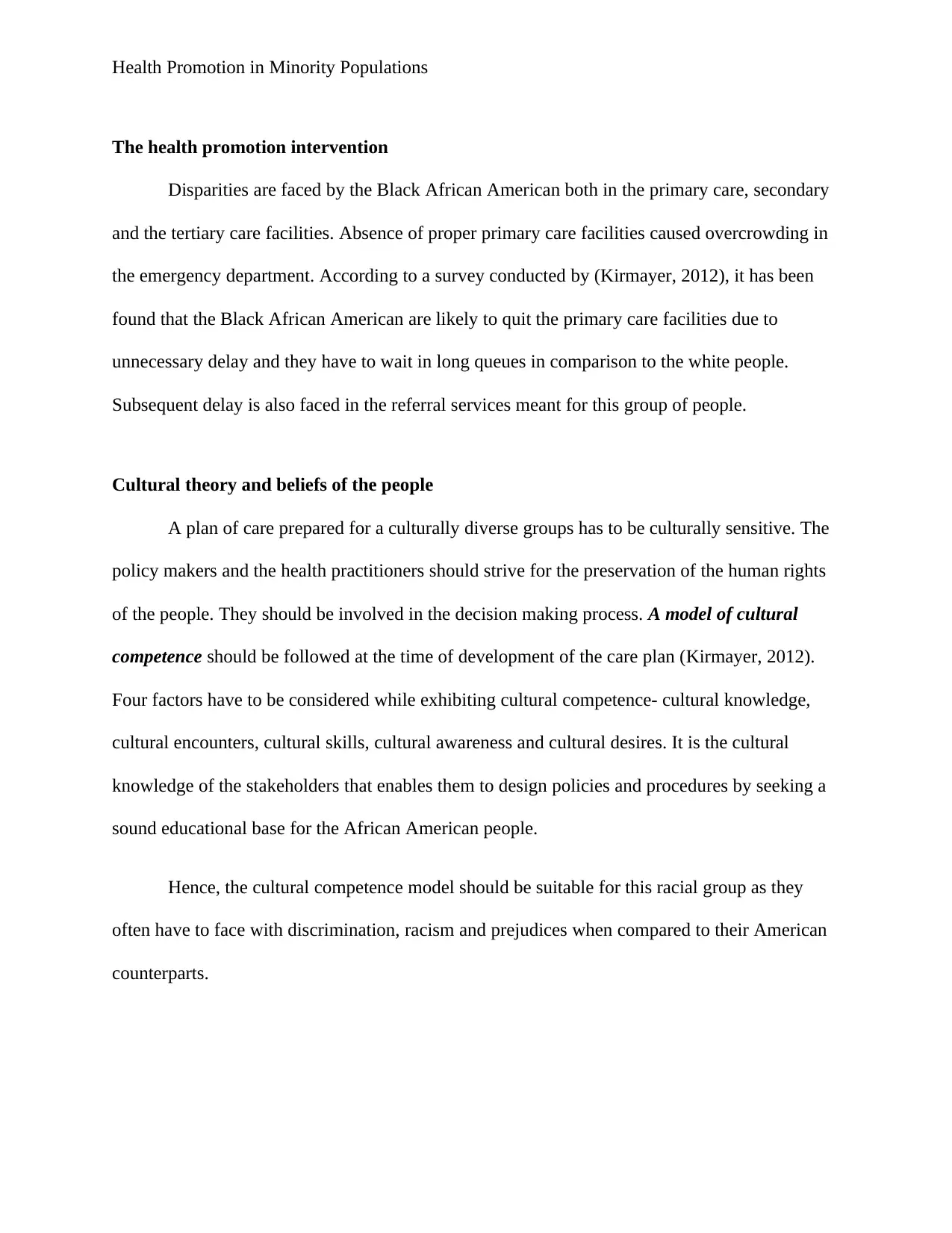
Health Promotion in Minority Populations
The health promotion intervention
Disparities are faced by the Black African American both in the primary care, secondary
and the tertiary care facilities. Absence of proper primary care facilities caused overcrowding in
the emergency department. According to a survey conducted by (Kirmayer, 2012), it has been
found that the Black African American are likely to quit the primary care facilities due to
unnecessary delay and they have to wait in long queues in comparison to the white people.
Subsequent delay is also faced in the referral services meant for this group of people.
Cultural theory and beliefs of the people
A plan of care prepared for a culturally diverse groups has to be culturally sensitive. The
policy makers and the health practitioners should strive for the preservation of the human rights
of the people. They should be involved in the decision making process. A model of cultural
competence should be followed at the time of development of the care plan (Kirmayer, 2012).
Four factors have to be considered while exhibiting cultural competence- cultural knowledge,
cultural encounters, cultural skills, cultural awareness and cultural desires. It is the cultural
knowledge of the stakeholders that enables them to design policies and procedures by seeking a
sound educational base for the African American people.
Hence, the cultural competence model should be suitable for this racial group as they
often have to face with discrimination, racism and prejudices when compared to their American
counterparts.
The health promotion intervention
Disparities are faced by the Black African American both in the primary care, secondary
and the tertiary care facilities. Absence of proper primary care facilities caused overcrowding in
the emergency department. According to a survey conducted by (Kirmayer, 2012), it has been
found that the Black African American are likely to quit the primary care facilities due to
unnecessary delay and they have to wait in long queues in comparison to the white people.
Subsequent delay is also faced in the referral services meant for this group of people.
Cultural theory and beliefs of the people
A plan of care prepared for a culturally diverse groups has to be culturally sensitive. The
policy makers and the health practitioners should strive for the preservation of the human rights
of the people. They should be involved in the decision making process. A model of cultural
competence should be followed at the time of development of the care plan (Kirmayer, 2012).
Four factors have to be considered while exhibiting cultural competence- cultural knowledge,
cultural encounters, cultural skills, cultural awareness and cultural desires. It is the cultural
knowledge of the stakeholders that enables them to design policies and procedures by seeking a
sound educational base for the African American people.
Hence, the cultural competence model should be suitable for this racial group as they
often have to face with discrimination, racism and prejudices when compared to their American
counterparts.
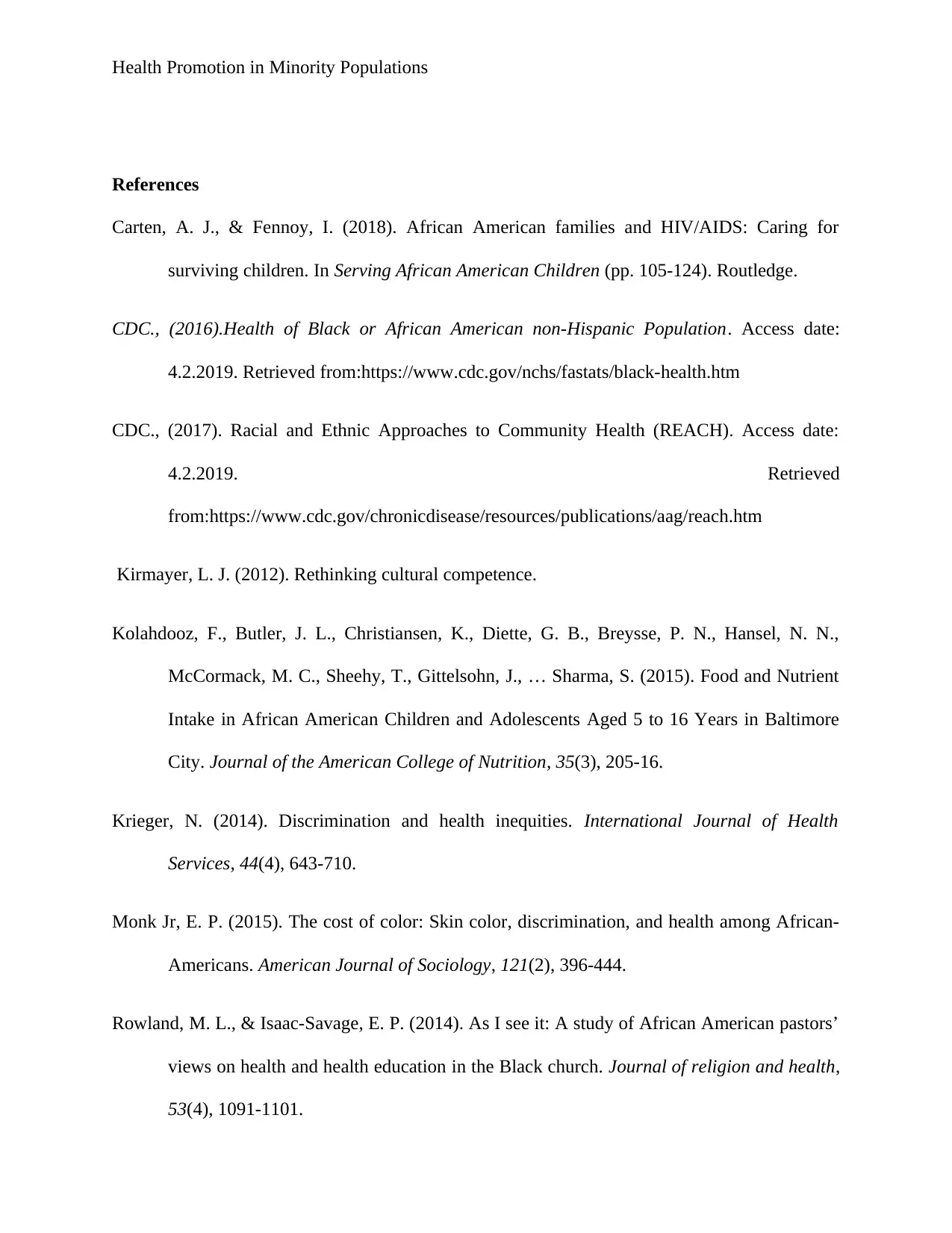
Health Promotion in Minority Populations
References
Carten, A. J., & Fennoy, I. (2018). African American families and HIV/AIDS: Caring for
surviving children. In Serving African American Children (pp. 105-124). Routledge.
CDC., (2016).Health of Black or African American non-Hispanic Population. Access date:
4.2.2019. Retrieved from:https://www.cdc.gov/nchs/fastats/black-health.htm
CDC., (2017). Racial and Ethnic Approaches to Community Health (REACH). Access date:
4.2.2019. Retrieved
from:https://www.cdc.gov/chronicdisease/resources/publications/aag/reach.htm
Kirmayer, L. J. (2012). Rethinking cultural competence.
Kolahdooz, F., Butler, J. L., Christiansen, K., Diette, G. B., Breysse, P. N., Hansel, N. N.,
McCormack, M. C., Sheehy, T., Gittelsohn, J., … Sharma, S. (2015). Food and Nutrient
Intake in African American Children and Adolescents Aged 5 to 16 Years in Baltimore
City. Journal of the American College of Nutrition, 35(3), 205-16.
Krieger, N. (2014). Discrimination and health inequities. International Journal of Health
Services, 44(4), 643-710.
Monk Jr, E. P. (2015). The cost of color: Skin color, discrimination, and health among African-
Americans. American Journal of Sociology, 121(2), 396-444.
Rowland, M. L., & Isaac-Savage, E. P. (2014). As I see it: A study of African American pastors’
views on health and health education in the Black church. Journal of religion and health,
53(4), 1091-1101.
References
Carten, A. J., & Fennoy, I. (2018). African American families and HIV/AIDS: Caring for
surviving children. In Serving African American Children (pp. 105-124). Routledge.
CDC., (2016).Health of Black or African American non-Hispanic Population. Access date:
4.2.2019. Retrieved from:https://www.cdc.gov/nchs/fastats/black-health.htm
CDC., (2017). Racial and Ethnic Approaches to Community Health (REACH). Access date:
4.2.2019. Retrieved
from:https://www.cdc.gov/chronicdisease/resources/publications/aag/reach.htm
Kirmayer, L. J. (2012). Rethinking cultural competence.
Kolahdooz, F., Butler, J. L., Christiansen, K., Diette, G. B., Breysse, P. N., Hansel, N. N.,
McCormack, M. C., Sheehy, T., Gittelsohn, J., … Sharma, S. (2015). Food and Nutrient
Intake in African American Children and Adolescents Aged 5 to 16 Years in Baltimore
City. Journal of the American College of Nutrition, 35(3), 205-16.
Krieger, N. (2014). Discrimination and health inequities. International Journal of Health
Services, 44(4), 643-710.
Monk Jr, E. P. (2015). The cost of color: Skin color, discrimination, and health among African-
Americans. American Journal of Sociology, 121(2), 396-444.
Rowland, M. L., & Isaac-Savage, E. P. (2014). As I see it: A study of African American pastors’
views on health and health education in the Black church. Journal of religion and health,
53(4), 1091-1101.

Health Promotion in Minority Populations
1 out of 7
Related Documents
Your All-in-One AI-Powered Toolkit for Academic Success.
+13062052269
info@desklib.com
Available 24*7 on WhatsApp / Email
![[object Object]](/_next/static/media/star-bottom.7253800d.svg)
Unlock your academic potential
© 2024 | Zucol Services PVT LTD | All rights reserved.





